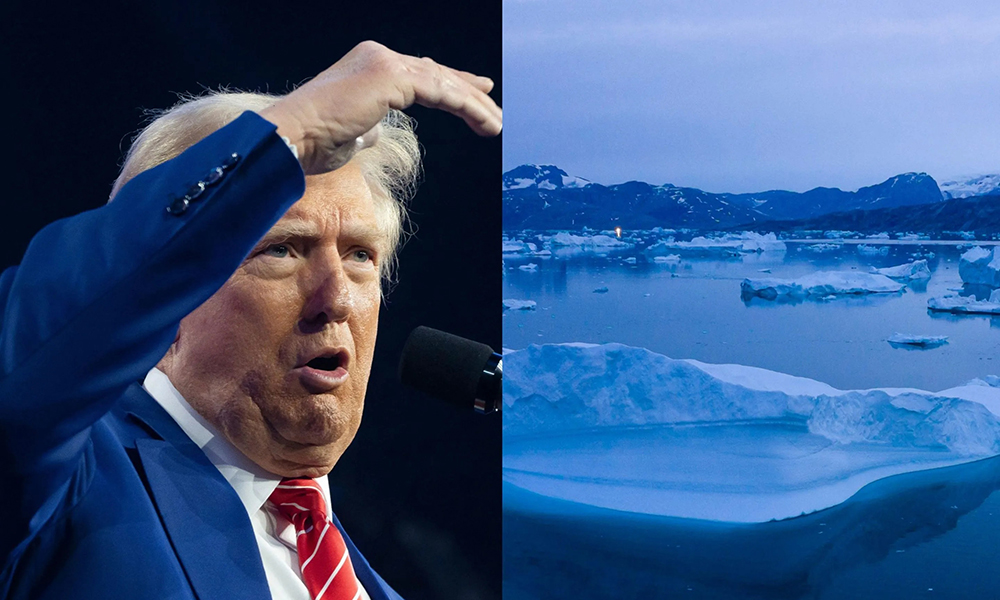
地处偏远、天气寒冷且基本没有经过开发的格陵兰岛,在数十亿人经历的日常天气和全球气候变化中扮演着重要角色。
俄亥俄大学(Ohio University)安全与环境教授杰夫·达贝尔科表示,格陵兰岛是气候变化、稀缺资源、紧张的地缘政治局势和新贸易模式交汇的地方。
达贝尔科表示,这个世界上最大的岛屿现在“在许多方面成为地缘政治和地缘经济竞争的中心”,气候变化是造成这种现象的部分原因。
自第一个任期以来,当选总统唐纳德·特朗普就一直对获得格陵兰岛表现出浓厚兴趣。格陵兰岛是丹麦的一个半自治领地,丹麦是美国的长期盟友,也是北约的创始成员国之一。格陵兰岛上还有一座大型美国军事基地。
特朗普为什么想要获得格陵兰岛?
纽约大学(New York University)气候科学家大卫·霍兰德表示,可以将格陵兰岛视为一个打开的冰箱门,或者是日益变暖的世界的恒温器,它所在地区的变暖速度比全球其他地区快四倍。
岛内拥有电信行业所需的宝贵稀土矿物,以及铀、数十亿桶未开发的石油和大量天然气,这些天然气曾经难以开采,但现在开采变得较为容易。
达贝尔科表示,目前许多矿物主要由中国供应,因此美国等其他国家才会对格陵兰岛感兴趣。三年前,丹麦政府暂停了该地区的海上石油开采项目。该地区拥有57,000人口。
但加州大学尔湾分校(University of California, Irvine)的气候科学家埃里克·里尼奥特表示,比石油、天然气或矿物更重要的是,格陵兰岛上还有大量的冰。
如果这些冰融化,将重塑全球海岸线,并可能使天气模式发生巨大变化,这种威胁甚至会成为好莱坞灾难电影的脚本。格陵兰岛上的冰如果全部融化,全球海平面将上升24英尺(7.4米)。2022年的一项研究发现,岛上近一英尺厚的冰是所谓的僵尸冰,无论如何注定都会融化。
自1992年以来,格陵兰岛每年约有1,820亿吨(1,690亿公吨)冰消失,2019年这个数字达到了每年4,890亿吨(4,440亿公吨)。
科罗拉多州博尔德国家冰雪数据中心(National Snow and Ice Data Center)主任马克·塞雷泽表示,由于融化的冰盖对海平面的影响,格陵兰岛将在21世纪成为“一个关键的焦点”。“它可能在未来产生更大的影响。”
纽约大学的霍兰德表示,这种影响“也许是不可阻挡的”。
格陵兰岛对气候变化有什么影响?
格陵兰岛还充当了一条关键洋流的引擎和开关,这条洋流在许多方面影响着地球的气候,包括飓风和冬季风暴活动。塞雷泽表示,这条洋流被称为大西洋经向翻转环流(AMOC),由于格陵兰岛融化的冰将更多的淡水注入海洋,大西洋经向翻转环流正在减缓。
大西洋经向翻转环流停止流动是一个非常令人担忧的气候临界点,可能会使欧洲和北美部分地区陷入长期的冰冻,就像2004年的电影《后天》(The Day After Tomorrow)中所描绘的那样。
伍德威尔气候研究中心(Woodwell Climate Research Center)的气候科学家詹妮弗·弗朗西斯表示:“如果这个全球洋流系统大幅减缓甚至完全停止流动——正如我们所知,它在过去曾经发生过这样的情况——全球的正常温度和降水模式将发生剧烈变化。农业将被破坏,生态系统将崩溃,‘正常’天气将成为历史。”
霍兰德表示,随着格陵兰岛的冰层融化,它的颜色也在发生变化,从反射阳光、热量和能量的冰的白色,变成海洋和陆地的蓝色和绿色,吸收更多的能量。
美国三分之二的地区目前正在经历严重冰冻天气,格陵兰岛在其中产生了一定的影响。私营公司大气与环境研究中心(Atmospheric and Environmental Research)的冬季天气专家朱达·科恩表示,2012年,格陵兰岛的天气模式是导致超级风暴“桑迪”袭击纽约州和新泽西州的罪魁祸首。
由于格陵兰岛的冰山,它还改变了喷流的模式,而喷流会将风暴带到全球,并对日常天气产生决定性影响。科恩表示,通常情况下,尤其是在冬季,格陵兰岛附近的阻塞高压会导致北极空气向西和向东倾泻,袭击北美和欧洲。
为什么格陵兰岛的地理位置如此重要?
由于格陵兰岛横跨美国、俄罗斯和欧洲之间的北极圈,在地缘政治方面,这里一直是美国和其他国家150多年来觊觎已久的宝贵资产。随着北极地区的航运和贸易增多,它的价值也越来越高。
这些都没有考虑到这个坚冰覆盖的岛屿独特的外观,这里还有一些地球上最古老的岩石。
自2007年以来,霍兰德在冰上进行了30多次研究。他表示:“我认为这里的景色美不胜收。身临其境令人眼花缭乱。像帝国大厦一样大的冰块从悬崖上崩塌,坠入海洋。这里还有美丽的野生动物,各种海豹和虎鲸。真是令人叹为观止。”(财富中文网)
译者:刘进龙
审校:汪皓
地处偏远、天气寒冷且基本没有经过开发的格陵兰岛,在数十亿人经历的日常天气和全球气候变化中扮演着重要角色。
俄亥俄大学(Ohio University)安全与环境教授杰夫·达贝尔科表示,格陵兰岛是气候变化、稀缺资源、紧张的地缘政治局势和新贸易模式交汇的地方。
达贝尔科表示,这个世界上最大的岛屿现在“在许多方面成为地缘政治和地缘经济竞争的中心”,气候变化是造成这种现象的部分原因。
自第一个任期以来,当选总统唐纳德·特朗普就一直对获得格陵兰岛表现出浓厚兴趣。格陵兰岛是丹麦的一个半自治领地,丹麦是美国的长期盟友,也是北约的创始成员国之一。格陵兰岛上还有一座大型美国军事基地。
特朗普为什么想要获得格陵兰岛?
纽约大学(New York University)气候科学家大卫·霍兰德表示,可以将格陵兰岛视为一个打开的冰箱门,或者是日益变暖的世界的恒温器,它所在地区的变暖速度比全球其他地区快四倍。
岛内拥有电信行业所需的宝贵稀土矿物,以及铀、数十亿桶未开发的石油和大量天然气,这些天然气曾经难以开采,但现在开采变得较为容易。
达贝尔科表示,目前许多矿物主要由中国供应,因此美国等其他国家才会对格陵兰岛感兴趣。三年前,丹麦政府暂停了该地区的海上石油开采项目。该地区拥有57,000人口。
但加州大学尔湾分校(University of California, Irvine)的气候科学家埃里克·里尼奥特表示,比石油、天然气或矿物更重要的是,格陵兰岛上还有大量的冰。
如果这些冰融化,将重塑全球海岸线,并可能使天气模式发生巨大变化,这种威胁甚至会成为好莱坞灾难电影的脚本。格陵兰岛上的冰如果全部融化,全球海平面将上升24英尺(7.4米)。2022年的一项研究发现,岛上近一英尺厚的冰是所谓的僵尸冰,无论如何注定都会融化。
自1992年以来,格陵兰岛每年约有1,820亿吨(1,690亿公吨)冰消失,2019年这个数字达到了每年4,890亿吨(4,440亿公吨)。
科罗拉多州博尔德国家冰雪数据中心(National Snow and Ice Data Center)主任马克·塞雷泽表示,由于融化的冰盖对海平面的影响,格陵兰岛将在21世纪成为“一个关键的焦点”。“它可能在未来产生更大的影响。”
纽约大学的霍兰德表示,这种影响“也许是不可阻挡的”。
格陵兰岛对气候变化有什么影响?
格陵兰岛还充当了一条关键洋流的引擎和开关,这条洋流在许多方面影响着地球的气候,包括飓风和冬季风暴活动。塞雷泽表示,这条洋流被称为大西洋经向翻转环流(AMOC),由于格陵兰岛融化的冰将更多的淡水注入海洋,大西洋经向翻转环流正在减缓。
大西洋经向翻转环流停止流动是一个非常令人担忧的气候临界点,可能会使欧洲和北美部分地区陷入长期的冰冻,就像2004年的电影《后天》(The Day After Tomorrow)中所描绘的那样。
伍德威尔气候研究中心(Woodwell Climate Research Center)的气候科学家詹妮弗·弗朗西斯表示:“如果这个全球洋流系统大幅减缓甚至完全停止流动——正如我们所知,它在过去曾经发生过这样的情况——全球的正常温度和降水模式将发生剧烈变化。农业将被破坏,生态系统将崩溃,‘正常’天气将成为历史。”
霍兰德表示,随着格陵兰岛的冰层融化,它的颜色也在发生变化,从反射阳光、热量和能量的冰的白色,变成海洋和陆地的蓝色和绿色,吸收更多的能量。
美国三分之二的地区目前正在经历严重冰冻天气,格陵兰岛在其中产生了一定的影响。私营公司大气与环境研究中心(Atmospheric and Environmental Research)的冬季天气专家朱达·科恩表示,2012年,格陵兰岛的天气模式是导致超级风暴“桑迪”袭击纽约州和新泽西州的罪魁祸首。
由于格陵兰岛的冰山,它还改变了喷流的模式,而喷流会将风暴带到全球,并对日常天气产生决定性影响。科恩表示,通常情况下,尤其是在冬季,格陵兰岛附近的阻塞高压会导致北极空气向西和向东倾泻,袭击北美和欧洲。
为什么格陵兰岛的地理位置如此重要?
由于格陵兰岛横跨美国、俄罗斯和欧洲之间的北极圈,在地缘政治方面,这里一直是美国和其他国家150多年来觊觎已久的宝贵资产。随着北极地区的航运和贸易增多,它的价值也越来越高。
这些都没有考虑到这个坚冰覆盖的岛屿独特的外观,这里还有一些地球上最古老的岩石。
自2007年以来,霍兰德在冰上进行了30多次研究。他表示:“我认为这里的景色美不胜收。身临其境令人眼花缭乱。像帝国大厦一样大的冰块从悬崖上崩塌,坠入海洋。这里还有美丽的野生动物,各种海豹和虎鲸。真是令人叹为观止。”(财富中文网)
译者:刘进龙
审校:汪皓
Remote, icy and mostly pristine, Greenland plays an outsized role in the daily weather experienced by billions of people and in the climate changes taking shape all over the planet.
Greenland is where climate change, scarce resources, tense geopolitics and new trade patterns all intersect, said Ohio University security and environment professor Geoff Dabelko.
The world’s largest island is now “central to the geopolitical, geoeconomic competition in many ways,” partly because of climate change, Dabelko said.
Since his first term in office, President-elect Donald Trump has expressed interest in acquiring Greenland, which is a semiautonomous territory of Denmark, a longtime U.S. ally and a founding member of NATO. It is also home to a large U.S. military base.
Why does Trump want Greenland?
Think of Greenland as an open refrigerator door or thermostat for a warming world, and it’s in a region that is warming four times faster than the rest of the globe, said New York University climate scientist David Holland.
Locked inside are valuable rare earth minerals needed for telecommunications, as well as uranium, billions of untapped barrels of oil and a vast supply of natural gas that used to be inaccessible but is becoming less so.
Many of the same minerals are currently being supplied mostly by China, so other countries such as the United States are interested, Dabelko said. Three years ago, the Denmark government suspended oil development offshore from the territory of 57,000 people.
But more than the oil, gas or minerals, there’s ice — a “ridiculous” amount, said climate scientist Eric Rignot of the University of California, Irvine.
If that ice melts, it would reshape coastlines across the globe and potentially shift weather patterns in such a dramatic manner that the threat was the basis of a Hollywood disaster movie. Greenland holds enough ice that if it all melts, the world’s seas would rise by 24 feet (7.4 meters). Nearly a foot of that is so-called zombie ice, already doomed to melt no matter what happens, a 2022 study found.
Since 1992, Greenland has lost about 182 billion tons (169 billion metric tons) of ice each year, with losses hitting 489 billion tons a year (444 billion metric tons) in 2019.
Greenland will be “a key focus point” through the 21st century because of the effect its melting ice sheet will have on sea levels, said Mark Serreze, director of the National Snow and Ice Data Center in Boulder, Colorado. “It will likely become a bigger contributor in the future.”
That impact is “perhaps unstoppable,” NYU’s Holland said.
What does Greenland have to do with climate change?
Greenland also serves as the engine and on/off switch for a key ocean current that influences Earth’s climate in many ways, including hurricane and winter storm activity. It’s called the Atlantic Meridional Overturning Circulation, or AMOC, and it’s slowing down because more fresh water is being dumped into the ocean by melting ice in Greenland, Serreze said.
A shutdown of the AMOC conveyor belt is a much-feared climate tipping point that could plunge Europe and parts of North America into prolonged freezes, a scenario depicted in the 2004 movie “The Day After Tomorrow.”
“If this global current system were to slow substantially or even collapse altogether — as we know it has done in the past — normal temperature and precipitation patterns around the globe would change drastically,” said climate scientist Jennifer Francis of the Woodwell Climate Research Center. “Agriculture would be derailed, ecosystems would crash, and ‘normal’ weather would be a thing of the past.”
Greenland is also changing color as it melts from the white of ice, which reflects sunlight, heat and energy away from the planet, to the blue and green of the ocean and land, which absorb much more energy, Holland said.
Greenland plays a role in the dramatic freeze that two-thirds of the United States is currently experiencing. And back in 2012, weather patterns over Greenland helped steer Superstorm Sandy into New York and New Jersey, according to winter weather expert Judah Cohen of the private firm Atmospheric and Environmental Research.
Because of Greenland’s mountains of ice, it also changes patterns in the jet stream, which brings storms across the globe and dictates daily weather. Often, especially in winter, a blocking system of high pressure off Greenland causes Arctic air to plunge to the west and east, smacking North America and Europe, Cohen said.
Why is Greenland’s location so important?
Because it straddles the Arctic circle between the United States, Russia and Europe, Greenland is a geopolitical prize that the U.S. and others have eyed for more than 150 years. It’s even more valuable as the Arctic opens up more to shipping and trade.
None of that takes into consideration the unique look of the ice-covered island that has some of the Earth’s oldest rocks.
“I see it as insanely beautiful. It’s eye-watering to be there,” said Holland, who has conducted research on the ice more than 30 times since 2007. “Pieces of ice the size of the Empire State Building are just crumbling off cliffs and crashing into the ocean. And also, the beautiful wildlife, all the seals and the killer whales. It’s just breathtaking.”






